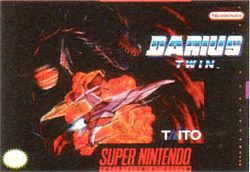- Darius Twin
-
Darius Twin 
Cover artDeveloper(s) Taito Publisher(s) Taito Platform(s) Super Nintendo Entertainment System, Virtual Console Release date(s) SNES
Virtual Console
Genre(s) Horizontal scrolling shooter Mode(s) Single-player, 2 player Co-op Rating(s) - ESRB: E
Media/distribution Super NES cartridge Darius Twin is a horizontal scrolling shooter for the Super Nintendo, released in 1991 and is part of the Darius series. It was re-released on the Wii Virtual Console in Japan on April 13, 2010 and in North America on December 13, 2010.
Contents
Story
Taking place sometime after Darius II, Proco and Tiat realized just how far Belser had reached into space and hurried back to Orga in hopes of warning the populace. The time they were gone was just enough time for Belser's allies to regroup and spread beyond Darius and begin their invasion of Orga. Once again, Proco and Tiat are quick to throw themselves into battle.
Gameplay
Though similar to the arcade Darius entries, Darius Twin featured slightly different gameplay features, most notably in the player's power-ups. Players collected weapon and shield power-ups from square shaped enemies that approached the player from the front and behind, but once players died after collecting a certain amount of power-ups, the power-ups the player collected stayed with the ship post-destruction. Players 1 and 2 were allowed their own separate amounts of lives, but there were no continues in the game.
The game contains five color-coded classes of power-up. The pink item powers up the main weapon, green powers up the side weapons, blue regenerates and/or improves the force shield, orange gives one extra Silver Hawk, and yellow destroys all enemies onscreen. At two points in the game, the player can find a red power-up with a special purpose. It switches the main weapon shot style between that seen in Darius and Darius II.
Captains
Darius Twin adopts from Darius II the idea of the Captains, mid-bosses that are smaller forms of bosses from previous Darius games:
- Little Stripes (angelfish)
- Guard Savage (tiger shark)
- My Home Daddy (hermit crab)
- Burst Out (pufferfish)
In the last stage of the game, the only enemies that are placed before the bosses are Captains.
Bosses
- Zone A: Killer Higia (mackerel)
- Zones B and C: Emperor Fossil and Queen Fossil (both coelacants)
- Zone D: Demon Sword (squid)
- Zones E and F: Dual Shears SP (lobster)
- Zones G and I: Dark Coronatus (crowned seahorse)
- Zone H: Red Mist (octopus)
- Zone J: Full Metal Shell (sea turtle)
- Zone K: Hyper Great Thing (sperm whale)
- Zone L: Like the Mercury stage on Darius II, this stage has 2 bosses in succession. The first one is Super Alloy Lantern (anglerfish). After Super Alloy Lantern is defeated or after a certain time, the player(s) will enter its interior to fight Great Tusk (walrus).
Endings
This is the only Darius game where there is only one final stage. As a result, Taito adopted a unique ending modality. There are four endings, each triggered by certain actions in-game:
- "Try Again" Ending: Didn't destroy Super Alloy Lantern (the player still must defeat Great Tusk).
- Average Ending: Lost 2 or more lives during the entire game.
- Good Ending: Lost 1 life during the entire game.
- Great Ending: Destroyed Full Metal Shell without losing a single life during the entire game.
- True Ending: Destroyed Hyper Great Thing without losing a single life during the entire game.
The four latter endings will never trigger unless Super Alloy Lantern is destroyed.
External links
Darius video games Arcade games Console-exclusive games Related games Categories:- 1991 video games
- Darius
- Super Nintendo Entertainment System games
- Virtual Console games
Wikimedia Foundation. 2010.
